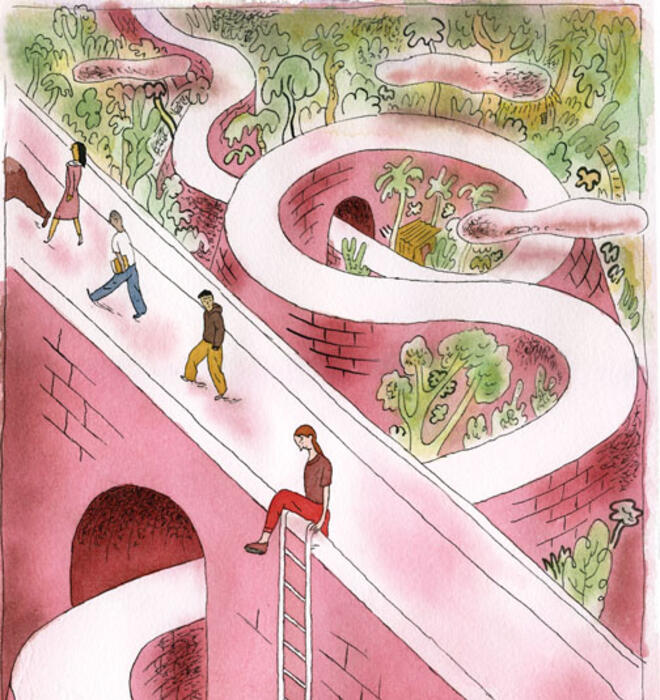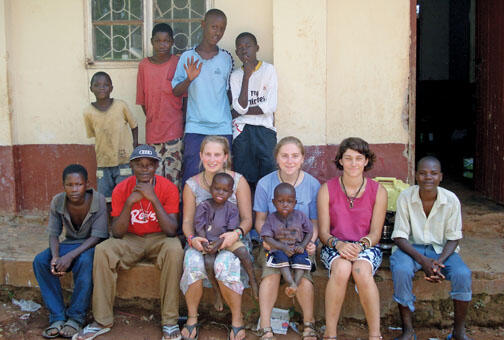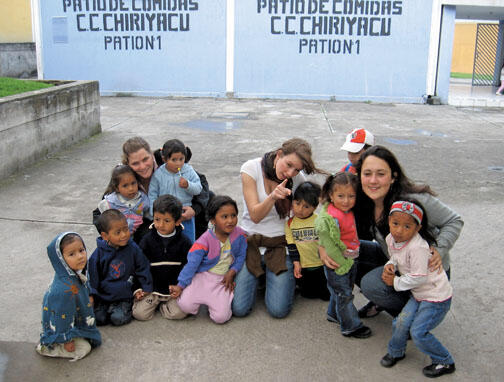
Mind the gap
For some students, the best way to kick off a Princeton education is to go somewhere else
Annie Sprogell could have started her freshman year at Princeton last fall as a member of the Class of 2012. But the demands of high school had been unrelenting: the pressure to ace her exams and papers, her spot on the varsity tennis team, and a slate of other activities — piano lessons, horseback-riding, and meetings of Amnesty International and an environmental-awareness group that she co-founded. When it all ended successfully, Sprogell realized, she needed a break. She didn’t want time off simply to relax or backpack from place to place; instead, she hoped to force herself out of her comfort zone to experience “something totally different from anything I’ve seen before,” she says.
So Sprogell, shy but determined, spent almost four months last fall teaching seventh grade in Muguluka, Uganda, before heading to France this semester for a study-abroad program. She wanted to imbue her time in Africa with a purpose that was deeper than casual travel, to experience day-to-day life as a Ugandan would. Her living conditions were “a bit daunting” at first, says Sprogell, who lived with three young British women teaching in the same service-abroad program, in a house a short walk from the school. “There were cockroaches in the outhouse, no running water, bats in the kitchen” and in her bedroom, she says. Electricity “might or might not come on at night.” She taught one 80-minute class each day to 70 students in a large, cement room crammed with as many long benches as could fit. Sometimes she taught outside, under a tent. With virtually no teaching experience, she sometimes wondered if the students were learning anything.
Still, Sprogell plowed on, and despite the challenges she faced as a new teacher in a new culture, she adapted. She believes she has grown in ways she might not have if she had jumped right into Princeton: She learned to rely on herself, to sleep through squeaking bats, that “the cockroaches won’t bother you if you don’t bother them, you don’t really need electricity until night anyway, and running water isn’t really necessary when you have a pump in the ground.” She’s become more outgoing. “It took me a really long time to get involved in things at my old school because I was too afraid to try new things or take risks, but that’s all this trip has been,” she says. Without the gap year, “I might have sat in my [Princeton] dorm the first few months with my nose in a book, avoiding chances to meet new people and try new things.”
Each year about 25 to 30 students delay their matriculation to Princeton, according to Janet Rapelye, the dean of admission. A small number of them spend their year off traveling, working, studying, or volunteering abroad or in the United States; others use the time to recover from illness or injury, care for family members, serve in the military, or perform as artists. Rapelye understands the intensity of the senior year of high school — a period that offers few opportunities for reflection. When a student asks for a year off, she grants it.
Now, the University is making it easier for students who want to delay matriculation specifically to do community service abroad by piloting a bridge-year program, believed to be the first of its kind among U.S. colleges and universities. The program will allow 20 students admitted to Princeton this spring to immerse themselves in another culture for nine months starting in the fall. In the future, that number might grow to 100 students per year, though expansion might have to wait until the economy — and Princeton’s budget — improves. (The pilot program is being funded by targeted contributions.) A working group charged with developing the program last year found that students who have taken such “gap” or “bridge” years have a “clearer sense of purpose” and use their time on campus more effectively, says comparative literature professor Sandra Bermann, who was the group’s chairwoman. “Nine months of cross-cultural living should begin to transform [bridge-year students] into more self-reflective citizens who will make service a part of their long-term goals,” she says. Proponents of the program believe that such a transformation won’t stop with the individuals — that the students will infuse the campus with their new interests and experiences.
Overseeing the new bridge-year program is director John Luria, whose interest in international travel began with his own year away, when he lived with a family in Luçon, France, and attended the local secondary school. “I came away from the experience with a much better sense of myself,” he says — “more mature, more self-assured” and “with a broader international perspective.” That experience sparked his interest in cross-cultural learning and set him on his career path. From 2002 until coming to Princeton in December, he was director of student services at the Council on International Educational Exchange (CIEE) Study Center in Seville, Spain. (The CIEE administers study-abroad programs in more than 40 countries.) In Seville, Luria developed and oversaw nonacademic support services, including housing, health and safety, and extracurricular activities. Before that, he managed services for international students at Georgetown University for 11 years.
At Princeton, Luria will oversee an initiative that offers students a choice of four locations with three partner organizations that run bridge-year programs: World Learning (founded by Donald Watt 1916) in Serbia and Ghana; ProWorld Service Corps in Urubamba, Peru; and Where There Be Dragons in Varanasi, India. These organizations, says Luria, have extensive experience in cultural-immersion and service-learning programs for young adults and work closely with local communities and groups. Each of the four sites will host five Princeton students.
After an orientation at Princeton in August, when the 20 selected students will learn about health, safety, and cultural issues, they will fly to their projects abroad and begin intensive language instruction. Staff members from the partner organizations will arrange home stays with local families and help ease the students into the countries. Luria says specific work assignments — which will be determined once the students are abroad — will be age-appropriate and will not take jobs from local residents. In Peru, students might help install clean-burning stoves in homes in rural villages, execute a public-health campaign directed toward women and children, or assist doctors providing health care. In India, students might work at an orphanage, a school, a social-service agency dedicated to assisting children of prostitutes, or a microfinance organization.
Students assigned to Ghana are likely to spend the first half of their stay in Accra, the capital, learning Ashanti Twi and working in a school for children with autism, a literacy center, an orphanage, or a family-outreach center; during the second half, they are expected to move to rural villages to serve as tutors and middle-school volunteers. In Serbia, the students will spend the first semester in Novi Sad — perhaps teaching English, organizing a human-rights festival, or working in a youth ecology camp. During the second semester, they will help build an ecotourism lodge in the Balkans Peace Park, on the border between Montenegro, Kosovo, and Albania. Luria’s office will keep tabs on the bridge-year students during their nine months abroad, and Princeton’s partner groups will plan additional activities such as day trips, lectures, and get-togethers so the students can discuss the issues they’re facing. When the students arrive on campus to begin their freshman year in the fall of 2010, Luria and his staff will find ways to “channel that energy that they bring to campus,” he says. “For us, the bridge-year program doesn’t end when they finish their year of service.”
Though the application and selection process still was being worked out when Luria spoke with PAW in January, he says he will look for mature students with a sense of adventure and a commitment to community service — students “who want to gain a deeper international perspective” and who can be away for nine months without needing to visit home. Princeton will cover program fees; parents will be responsible for incidentals including airfare and health insurance (financial aid will be available). Luria would not say what the costs would be, noting that the University still was negotiating with program providers. But Bermann notes that a major goal was to extend to all students what previously was available only to wealthier ones.
Until now, Princeton-bound students who wanted to take a year off between high school and college have needed to design their own gap years, often with service components. Students “want something more than what being in the box has given them,” says Sam Bull ’82, who, after graduating from high school, took a year to travel, study, and work in Europe and in 1994 started a study- and service-abroad program, Leapnow: Transforming Education. Traditional education takes “young people at the ages when they are most alive, most wanting to learn, most physically active, and we sit them down in chairs ... and tell them what they need to learn — and we do that for 16 years in a row,” Bull says. About 20 to 25 percent of the participants in his program have attended a year of college before taking their gap year as a way to step off the treadmill. “So much of self-esteem these days might be based on academics ... but a true self-esteem is based on finding some challenges and meeting them,” Bull says.
Haley White ’12 headed to Quito, Ecuador, after finishing high school, delaying her entrance into Princeton by a year. She didn’t want to show up at Freshman Orientation burnt out and without a focus, unable to take advantage of all Princeton had to offer. A gap year, she thought, would give her time to “stop and think about what I wanted to think about, and read what I wanted to read — figure out what makes me tick,” she says. With an interest in developing nations and six years of high school Spanish behind her, she set her sights on Latin America and found a position in Quito as a volunteer in a nonprofit nursery school.
For five months, White taught as many as 25 children, ages 3 to 8, in the middle of a noisy open-air market. There was no set classroom or attendance list. Instead, each morning White walked over crumbling steps leading from the road to the market and then from stall to stall to gather children from their parents. Sitting on the ground, she led her charges in lessons on brushing their teeth and washing their hands, and taught them letters, colors, and numbers. In her spare time, she read everything from Candide to Jhumpa Lahiri’s stories of India and Indian-Americans in Interpreter of Maladies, traveled in Ecuador and Peru, and gained perspective on the lives of people who were not headed to a place like Princeton.
Miriam Rosenbaum ’12 spent a gap year in Israel, studying Jewish culture and religious texts at Michalah-Jerusalem College for Women and volunteering at a home for children with special needs, where she worked with autistic children. A typical day involved teaching the students, who ranged in age from 12 to 15, simple life skills such as brushing their teeth and caring for themselves, and helping them develop motor skills. For two weeks she coached one student to spell her name; the girl finally got it, but quickly forgot how to form the letters. “The hardest thing was not seeing progress,” says Rosenbaum. But she’s glad that she could offer friendship — she was someone to play and laugh with, “someone to sit there and teach them to cut on a line.”
Students interviewed for this story — predominantly women, as are most students who have done service-oriented work during their gap years — say that when they arrived on campus after their time abroad, they felt more confident and resourceful, less stressed about grades, and raring to get back into studying, reading, and discussing ideas. Several say they have brought new insights into classroom discussions and papers, and are especially interested in interacting with international students. And they know how to do laundry, cook, and handle other details of daily life. Having seen people in dire need, and realizing that their own contributions were limited because they lacked important skills, they aim to
prepare themselves by learning as much as they can. Rosenbaum’s experience in Jerusalem, for example, clarified the direction her life would take. She now wants to go into research and contribute to a cure for autism, so she plans to major in psychology and pursue a certificate in neuroscience.
Megan Schoendorf ’10 returned from her gap year determined to learn the skills that would have helped her during her stint at a small NGO based in Yunnan Province, China: computer programming, Chinese language, and how to write more persuasively. The agency engaged in microfinance with poor villages, and Schoendorf performed a variety of tasks, including clerical work, writing reports, and cleaning up the computer database. Arriving at Princeton, she took a “more practical” view toward her education, focused more on acquiring knowledge than on grades.
Before her gap year, Schoendorf had planned on a career as an engineer; now she envisions herself doing that in Asia, possibly through the nonprofit Engineers Without Borders (EWB) or the Peace Corps. Her year away, she says, made her realize she wants to work for “something I really believe in.” She spent last summer in India working as a software engineer at a startup technology company outside of New Delhi through Princeton in Asia and studied last semester in Hong Kong. “My gap year changed who I was and what I wanted to do with my life,” Schoendorf says.
When White arrived at Princeton, she joined Princeton’s chapter of Engineers Without Borders and has worked with a team developing a solar-energy system and a water system for a village in Peru. She also is on EWB’s board, developing a newsletter and planning campus events. White has applied to work with an NGO in a developing country next summer though Princeton’s International Internship Program; long term, she is thinking about a career abroad in development work.
Her five-month stay in Ecuador opened her eyes to what it takes to fix a problem. “If you really want to have an impact in the world, you can’t do it by flitting off somewhere for four or five months,” White says. “You need to become involved in a community. You need to acquaint yourself with its values. ... and you need people to trust you. [My gap year] made me think more about what it means to make change in the world, and what’s really required.”
Katherine Federici Greenwood is an associate editor at PAW.







No responses yet